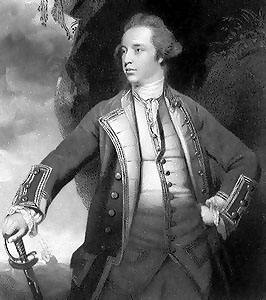RBH Biography: Sir George Bowyer (1739-1800) (original) (raw)
 Sir George Bowyer (1739-1800)
Born: 1739 in Denham, Buckinghamshire
Admiral of the Blue
Died: 6th December 1800 at Radley, Berkshire
Sir George Bowyer (1739-1800)
Born: 1739 in Denham, Buckinghamshire
Admiral of the Blue
Died: 6th December 1800 at Radley, Berkshire
Sir George Bowyer was the third son of Sir William Bowyer, bart. of Denham Court in Buckinghamshire and, by right of his wife, of Radley Hall in Berkshire. He attained the rank of lieutenant in the navy on 13th February 1758, commander on 4th May 1761 and captain on 28th October 1762, from which time he commanded the Sheerness frigate till Great Britain was at peace.
On the breaking out of the dispute with the colonies of North America, Bowyer was appointed to the Burford of 70 guns and, early in 1778, was transferred to the Albion of 74 guns, one of the squadron which sailed for North America with Vice-Admiral Byron. They accompanied each other to the West Indies, taking part in the Battle of Grenada, on 6th July 1779. Bowyer remained in the West Indies for two years longer and was present in Sir George Rodney's three actions with the Count de Guichen on 17th April and 15th and 19th May 1780, in which the Albion suffered severely in men, spars and hull, and had to be sent to Jamaica for repairs.
In 1783, Bowyer commissioned the Irresistible of 74 guns, as guardship in the Medway, and commanded there for the next two years, during which time he wore a commodore's broad pennant. In 1784, he was returned to parliament by the borough of Queenborough and, in 1785, was a member of a committee appointed to consider the defences of Portsmouth and Plymouth. On the occasion of the Spanish armament in 1790, he was appointed to the Boyne of 98 guns, a ship newly launched at Woolwich, which, however, was paid off towards the end of the year. On 1st February 1793, he was advanced to the rank of Rear-Admiral and, shortly afterwards, hoisted his flag in the Prince of 90 guns, in the Channel Fleet, under the command of Lord Howe. On 1st June 1794, Bowyer took an important part in the engagement off Ushaut, in which he sustained the loss of a leg. For this, he received a pension of �1,000 in addition to the chain and gold medal and, on 16th August, was created a baronet. His wound incapacitated him from further active service and he entered into semi-retirement at his country estate of Warfield Grove. In due course however, he was advanced to the rank of Vice-Admiral, on 4th July 1794, and, six months later, he inherited his mother�s family seat, at Radley Hall, from his cousin, Penelope, Lady Rivers. By the death of his brother, in April 1797, Sir George succeeded to the older family baronetcy, in which his newer title was merged and, on 14th February 1799, he was created a full admiral. He died at Radley on 6th December 1800. He was twice married: first to Lady Downing, widow of Sir Jacob Downing, bart. who died without issue; and second, to Henrietta, only daughter of Admiral Sir Piercy Brett, by whom he had three sons and two daughters.
Edited from Leslie Stephen's 'Dictionary of National Biography' (1886)
